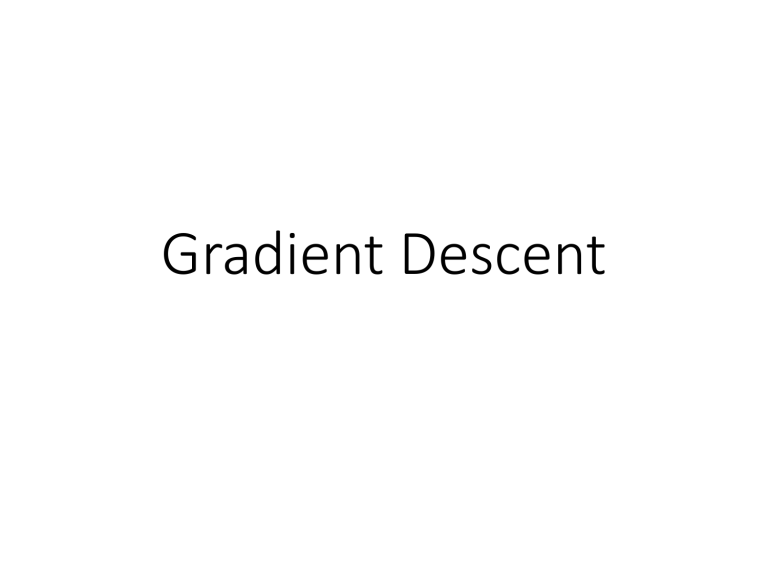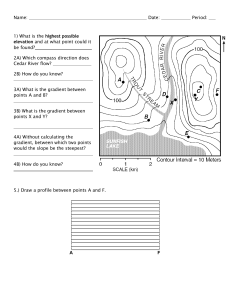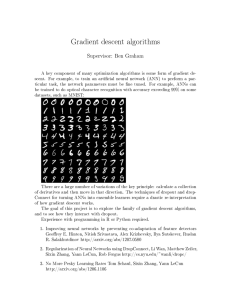
Gradient Descent
Review: Gradient Descent
• In step 3, we have to solve the following optimization
problem:
𝜃 ∗ = arg min 𝐿 𝜃
𝜃
L: loss function 𝜃: parameters
Suppose that θ has two variables {θ1, θ2}
0
𝜃
𝜕𝐿 𝜃1 Τ𝜕𝜃1
Randomly start at 𝜃 0 = 10
𝛻𝐿 𝜃 =
𝜃2
𝜕𝐿 𝜃2 Τ𝜕𝜃2
𝜃11
𝜃10
𝜕𝐿 𝜃10 Τ𝜕𝜃1
𝜃 1 = 𝜃 0 − 𝜂𝛻𝐿 𝜃 0
1 =
0 −𝜂
0 Τ
𝜃2
𝜃2
𝜕𝐿 𝜃2 𝜕𝜃2
𝜃12
𝜃11
𝜕𝐿 𝜃11 Τ𝜕𝜃1
1 −𝜂
2 =
𝜃2
𝜕𝐿 𝜃21 Τ𝜕𝜃2
𝜃2
𝜃 2 = 𝜃 1 − 𝜂𝛻𝐿 𝜃 1
Review: Gradient Descent
𝜃2
𝛻𝐿 𝜃 0
𝜃
Gradient: Loss 的等高線的法線方向
Start at position 𝜃 0
𝛻𝐿 𝜃 1
0
𝜃1
Gradient
Movement
Compute gradient at 𝜃 0
𝛻𝐿 𝜃 2
𝜃2
𝜃3
𝛻𝐿 𝜃 3
Move to 𝜃 1 = 𝜃 0 - η𝛻𝐿 𝜃 0
Compute gradient at 𝜃 1
Move to 𝜃 2 = 𝜃 1 – η𝛻𝐿 𝜃 1
……
𝜃1
Gradient Descent
Tip 1: Tuning your
learning rates
i
Learning Rate
If there are more than three
parameters, you cannot
visualize this.
i 1
L
i 1
Set the learning rate η carefully
Loss
Very Large
small
Large
Loss
Just make
No. of parameters updates
But you can always visualize this.
Adaptive Learning Rates
• Popular & Simple Idea: Reduce the learning rate by
some factor every few epochs.
• At the beginning, we are far from the destination, so we
use larger learning rate
• After several epochs, we are close to the destination, so
we reduce the learning rate
• E.g. 1/t decay: 𝜂 𝑡 = 𝜂 Τ 𝑡 + 1
• Learning rate cannot be one-size-fits-all
• Giving different parameters different learning
rates
Adagrad
𝜂𝑡 =
𝜂
𝑡+1
𝑡
𝜕𝐿
𝜃
𝑔𝑡 =
𝜕𝑤
• Divide the learning rate of each parameter by the
root mean square of its previous derivatives
Vanilla Gradient descent
𝑤 𝑡+1 ← 𝑤 𝑡 − 𝜂𝑡 𝑔𝑡
Adagrad
𝑤 𝑡+1
𝑡
𝜂
← 𝑤 𝑡 − 𝑡 𝑔𝑡
𝜎
w is one parameters
𝜎 𝑡 : root mean square of
the previous derivatives of
parameter w
Parameter dependent
𝜎 𝑡 : root mean square of
the previous derivatives of
parameter w
Adagrad
0
𝜂
𝑤 1 ← 𝑤 0 − 0 𝑔0
𝜎
1
𝜂
𝑤 2 ← 𝑤 1 − 1 𝑔1
𝜎
2
𝜂
𝑤 3 ← 𝑤 2 − 2 𝑔2
𝜎
𝜎0 =
2
1
1
𝑔0
2
2
+ 𝑔1
2
2
1
𝑔0
3
2
+ 𝑔1
2
𝜎 =
𝜎 =
……
𝑤 𝑡+1
𝑡
𝜂
← 𝑤 𝑡 − 𝑡 𝑔𝑡
𝜎
𝑔0
𝑡
𝜎𝑡
=
1
𝑔𝑖
𝑡+1
𝑖=0
2
+ 𝑔2
2
Adagrad
• Divide the learning rate of each parameter by the
root mean square of its previous derivatives
𝜂
𝑡
1/t decay
𝜂 =
𝑡
+
1
𝑡
𝜂𝜂
𝑡+1
𝑡
𝑤
← 𝑤 − 𝑡 𝑔𝑡
𝑡
𝜎
𝜎𝑡
1
𝑡
𝜎 =
𝑔𝑖 2
𝑡+1
𝑖=0
𝑤 𝑡+1
←
𝑤𝑡
−
𝜂
σ𝑡𝑖=0 𝑔𝑖
𝑔𝑡
2
Contradiction?
𝜂
𝜂𝑡 =
𝑡+1
𝑡
𝜕𝐿
𝜃
𝑔𝑡 =
𝜕𝑤
Vanilla Gradient descent
𝑤 𝑡+1
←
𝑤𝑡
Larger gradient,
larger step
− 𝜂 𝑡 𝑔𝑡
Adagrad
𝑤 𝑡+1
←
𝑤𝑡
−
𝜂
σ𝑡𝑖=0 𝑔𝑖
𝑔𝑡
Larger gradient,
larger step
2
Larger gradient,
smaller step
𝜂
𝑡
𝜕𝐶
𝜃
𝜂𝑡 =
𝑔𝑡 =
𝑡+1
𝜕𝑤
Intuitive Reason
• How surprise it is 反差
𝑤
特別大
g0
g1
g2
g3
g4
0.001 0.001 0.003 0.002 0.1
……
……
g0
10.8
……
……
𝑡+1
g1
20.9
𝑡
←𝑤 −
g2
31.7
g3
12.1
特別小
𝜂
σ𝑡𝑖=0 𝑔𝑖
g4
0.1
𝑔𝑡
2
造成反差的效果
Larger gradient, larger steps?
Best step:
𝑏
|𝑥0 +
|
2𝑎
1st
Larger order
derivative means far
from the minima
𝑦 = 𝑎𝑥 2 + 𝑏𝑥 + 𝑐
|2𝑎𝑥0 + 𝑏|
2𝑎
𝑥0
𝑏
−
2𝑎
|2𝑎𝑥0 + 𝑏|
𝜕𝑦
= |2𝑎𝑥 + 𝑏|
𝜕𝑥
𝑥0
Larger 1st order
derivative means far
from the minima
Do not cross parameters
Comparison between
different parameters
a
a>b
b
𝑤1
𝑤2
c
c>d
𝑤1
d
𝑤2
Second Derivative
𝑦 = 𝑎𝑥 2 + 𝑏𝑥 + 𝑐
𝜕𝑦
= |2𝑎𝑥 + 𝑏|
𝜕𝑥
𝜕2𝑦
= 2𝑎
2
𝜕𝑥
Best step:
𝑏
|𝑥0 +
|
2𝑎
|2𝑎𝑥0 + 𝑏|
2𝑎
𝑥0
𝑏
−
2𝑎
|2𝑎𝑥0 + 𝑏|
The best step is
𝑥0
|First derivative|
Second derivative
Larger 1st order
derivative means far
from the minima
Do not cross parameters
Comparison between
different parameters
The best step is
Larger
Second
|First derivative|
Second derivative
a
a>b
b
𝑤1
smaller second derivative
𝑤2
c
Smaller
Second
𝑤1
c>d
d
𝑤2
Larger second derivative
𝜂
𝑤 𝑡+1 ← 𝑤 𝑡 −
σ𝑡𝑖=0 𝑔𝑖
The best step is
𝑔𝑡
|First derivative|
2
?
Second derivative
Use first derivative to estimate second derivative
larger second
derivative
smaller second
derivative
𝑤1
first derivative
2
𝑤2
Gradient Descent
Tip 2: Stochastic
Gradient Descent
Make the training faster
Stochastic Gradient Descent
2
Loss is the summation over
all training examples
𝐿 = 𝑦ො 𝑛 − 𝑏 + 𝑤𝑖 𝑥𝑖𝑛
𝑛
Gradient Descent i i 1 L i 1
Stochastic Gradient Descent
Pick an example xn
𝐿𝑛 = 𝑦ො 𝑛 − 𝑏 + 𝑤𝑖 𝑥𝑖𝑛
Loss for only one example
2
Faster!
i i 1 Ln i 1
• Demo
Stochastic Gradient Descent
Stochastic Gradient Descent
Gradient Descent
Update after seeing all
examples
See all
examples
Update for each example
If there are 20 examples,
20 times faster.
See only one
example
See all
examples
Gradient Descent
Tip 3: Feature Scaling
Source of figure:
http://cs231n.github.io/neuralnetworks-2/
Feature Scaling
𝑦 = 𝑏 + 𝑤1 𝑥1 + 𝑤2 𝑥2
𝑥2
𝑥2
𝑥1
𝑥1
Make different features have the same scaling
𝑦 = 𝑏 + 𝑤1 𝑥1 + 𝑤2 𝑥2
Feature Scaling
1, 2 ……
100, 200 ……
w2
x1
w1
w2
x2
y
1, 2 ……
1, 2 ……
b
w2
Loss L
w1
x1
w1
w2
x2
y
b
Loss L
w1
Feature Scaling
𝑥1
𝑥11
𝑥21
𝑥2
𝑥12
𝑥22
𝑥𝑟
𝑥3
𝑥𝑅
For each
dimension i:
……
……
……
……
……
……
𝑟
𝑥
𝑖 − 𝑚𝑖
𝑟
𝑥𝑖 ←
𝜎𝑖
……
mean: 𝑚𝑖
standard
deviation: 𝜎𝑖
The means of all dimensions are 0,
and the variances are all 1
Gradient Descent
Theory
Question
• When solving:
𝜃 ∗ = arg min 𝐿 𝜃
𝜃
by gradient descent
• Each time we update the parameters, we obtain 𝜃
that makes 𝐿 𝜃 smaller.
𝐿 𝜃 0 > 𝐿 𝜃1 > 𝐿 𝜃 2 > ⋯
Is this statement correct?
Warning of Math
Formal Derivation
• Suppose that θ has two variables {θ1, θ2}
2
2
Given a point, we can
easily find the point
with the smallest value
nearby. How?
1
0
1
L(θ)
Taylor Series
• Taylor series: Let h(x) be any function infinitely
differentiable around x = x0.
h k x0
k
x x0
h x
k!
k 0
h x0
2
x x0
h x0 h x0 x x0
2!
When x is close to x0
h x h x0 h x0 x x0
E.g. Taylor series for h(x)=sin(x) around x0=π/4
sin(x)=
……
The approximation
is good around π/4.
Multivariable Taylor Series
h x0 , y0
h x0 , y0
x x0
y y0
h x, y h x0 , y0
x
y
+ something related to (x-x0)2 and (y-y0)2 + ……
When x and y is close to x0 and y0
h x0 , y0
h x0 , y0
x x0
y y0
h x, y h x0 , y0
x
y
Back to Formal Derivation
Based on Taylor Series:
If the red circle is small enough, in the red circle
La, b
La, b
1 a
2 b
L La, b
1
2
s La, b
La, b
La, b
u
,v
1
2
L(θ)
2
a, b
L
s u 1 a v 2 b
1
Back to Formal Derivation
constant
Based on Taylor Series:
If the red circle is small enough, in the red circle
L s u 1 a v 2 b
Find θ1 and θ2 in the red circle
minimizing L(θ)
1 a 2 b
2
2
s La, b
La, b
La, b
u
,v
1
2
d2
L(θ)
2
Simple, right?
a, b
d
1
Gradient descent – two variables
Red Circle: (If the radius is small)
L s u 1 a v 2 b
1
2 1, 2
Find θ1 and θ2 in the red circle
minimizing L(θ)
1 a 2 b
2
1
2
1, 2
d2
u, v
2
To minimize L(θ)
1
u
v
2
1 a
u
b v
2
Back to Formal Derivation
Based on Taylor Series:
If the red circle is small enough, in the red circle
L s u 1 a v 2 b
constant
s La, b
La, b
La, b
u
,v
1
2
Find 𝜃1 and 𝜃2 yielding the smallest value of 𝐿 𝜃 in the circle
La, b
1 a
u
a
This is gradient
1
b
v
b
La, b descent.
2
2
Not satisfied if the red circle (learning rate) is not small enough
You can consider the second order term, e.g. Newton’s method.
End of Warning
More Limitation
of Gradient Descent
Loss
Very slow at
𝐿
the plateau
Stuck at
saddle point
𝑤1
𝑤2
Stuck at local minima
𝜕𝐿 ∕ 𝜕𝑤
≈0
𝜕𝐿 ∕ 𝜕𝑤
=0
The value of the parameter w
𝜕𝐿 ∕ 𝜕𝑤
=0
Acknowledgement
• 感謝 Victor Chen 發現投影片上的打字錯誤




